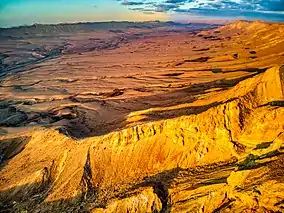


A makhtesh (Hebrew: מַכְתֵּשׁ ([maχˈteʃ]), Hebrew plural: מַכְתְּשִׁים ([ˌmaχteˈʃim] – Makhteshim) is a geological landform considered typical for the Negev desert of Israel and the Sinai peninsula of Egypt. A makhtesh has steep walls of resistant rock surrounding a deep closed valley, which is usually drained by a single wadi. The valleys have limited vegetation and soil, containing a variety of different colored rocks and diverse fauna and flora. The best known and largest makhtesh is Makhtesh Ramon.
Etymology
Although commonly referred to as "craters", these formations are "erosion cirques" (steephead valleys or box canyons). Craters are formed by the impact of a meteor or volcanic eruption, whereas makhteshim are created by erosion.[1]
The word makhtesh is the Hebrew word for a mortar grinder (מַכְתֵּשׁ).[2] The geological landform was given this name because of its similarity to a grinding bowl.
Geology
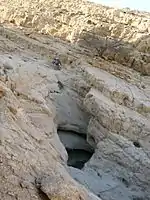
Where a hard outer layer of rock covers softer rocks, erosion removes the softer minerals relatively quickly, and they are washed away from under the harder rock. The harder rocks eventually collapse under their own weight, and a crater-like valley structure is formed. In Negev and Sinai makhteshes, the hard rocks are limestone and dolomites, while the inner softer rocks are chalk or sandstone.[3]
The center of the Negev is dominated by northeast-southwest anticlinal ridges. The crests of four ridges host five deep valleys surrounded by steep walls. The upper half consists of hard limestone and dolomite, and the bottom of friable sandstone. Each valley, known as a makhtesh, is drained by a narrow river bed.[4]
Negev
The Negev has five makhteshes: Makhtesh Ramon, Makhtesh Gadol, Makhtesh Katan, and two small makhteshes on Mount Arif, south of Makhtesh Ramon.
- Makhtesh Ramon is exceptional as it is drained by two rivers (Nahal Ramon and Nahal Ardon). It is the largest makhtesh at over 40 km long, 2–10 km wide and over 500 m deep. The rocks in this makhtesh contain thousands of ammonite fossils, as well as volcanic and metamorphic rocks.
- Makhtesh Gadol (Large Makhtesh). At the time of naming, Makhtesh Ramon was uncharted, and so this was thought to be the largest makhtesh, at 10 km by 5 km.
- Makhtesh Katan (Small Makhtesh) is the smallest major makhtesh at 7 km by 5 km and was charted in 1942 by Jewish explorers.

Sinai
The two makhteshes in Sinai, Egypt, have no names for the basin, but their walls have several names including Jabal al-Manzur or Gebel Maghara.
Jordan
Several similar geological formations are also found in Wadi Rum in southern Jordan.
Gallery
 The walls of Makhtesh Katan (the Small Makhtesh)
The walls of Makhtesh Katan (the Small Makhtesh) Colorful sandstone in Makhtesh Katan
Colorful sandstone in Makhtesh Katan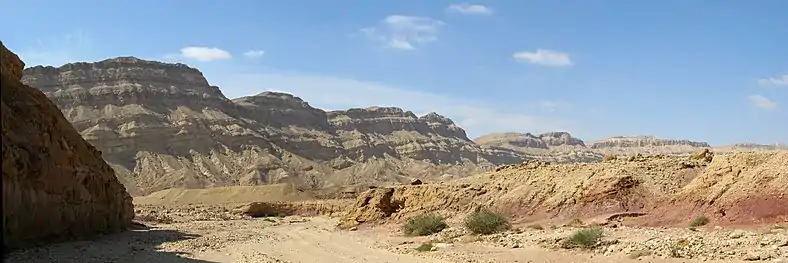 Makhtesh Katan
Makhtesh Katan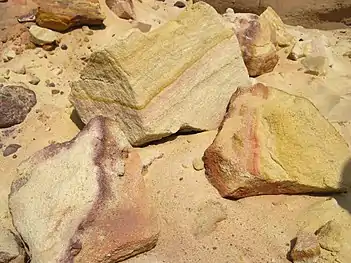 Colorful sandstone in the Small Makhtesh
Colorful sandstone in the Small Makhtesh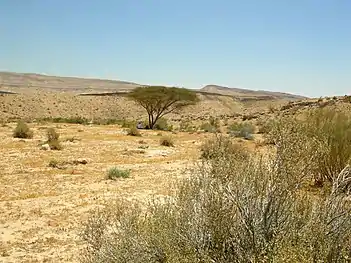 Acacia tree inside Makhtesh Gadol
Acacia tree inside Makhtesh Gadol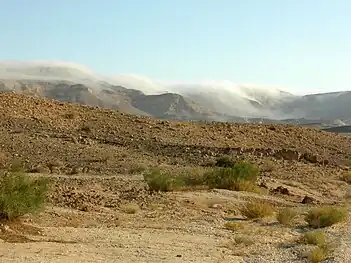 Mist flowing over the northern rim of Makhtesh Gadol
Mist flowing over the northern rim of Makhtesh Gadol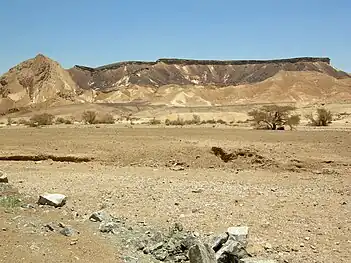 Ramon Monocline on the southern side of Makhtesh Ramon
Ramon Monocline on the southern side of Makhtesh Ramon Ramon Fault on the southern side of Makhtesh Ramon
Ramon Fault on the southern side of Makhtesh Ramon
References
- ↑ Desert ecology: Naming.
- ↑ Safa-Ivrit Hebrew Dictionary: מכתש (Hebrew).
- ↑ Conservation and the Desert: Rock types.
- ↑ Makhteshim Country at UNESCO World Heritage Convention. Submitted by Israel, 30/9/2001. Re-accessed 12/3/2023.
Further reading
- Mazor, Emanuel and Krasnov, Boris, editors "The Makhteshim Country - a Laboratory of Nature". Pensoft Publishers, Sofia, 2001, 411 pages. ISBN 978-954-642-135-7